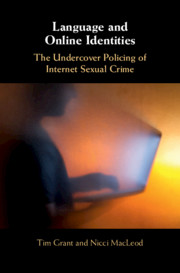Refine search
Actions for selected content:
3 results
6 - Multimeowdality
-
- Book:
- Purrieties of Language
- Published online:
- 06 April 2023
- Print publication:
- 27 April 2023, pp 138-172
-
- Chapter
- Export citation
Chapter 2 - Data and Methods
-
- Book:
- Language and Online Identities
- Published online:
- 10 February 2020
- Print publication:
- 13 February 2020, pp 26-57
-
- Chapter
- Export citation

Language and Online Identities
- The Undercover Policing of Internet Sexual Crime
-
- Published online:
- 10 February 2020
- Print publication:
- 13 February 2020
